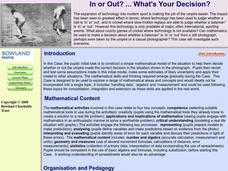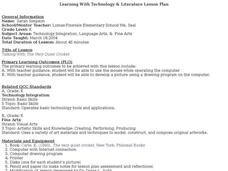Curated OER
A Home for a Cricket
First graders build a habitat for crickets after studying animal survival needs. They care for and observe the crickets in the classroom habitat.
Curated OER
The Effect of Temperature on Cricket Chirping
Students examine the effect of temperature on how often crickets chirp. In groups, they complete the experiment and answer lab discussion questions. They create a graph of temperatures and the amount of chirps and discuss the results.
Curated OER
Dissecting Crickets
Students dissect a cricket and note the three body regions, wings, and legs. They observe the yellow malphigian tubes and remove them. They dissect the esophagus and analyze the heart for respiratory rates and heart beat rates.
Curated OER
The Crickets in the Classroom Page
Learners observe crickets to practice observation, measurement and hypothesis skills. In this cricket lesson, students observe crickets mating, producing a calling song, and being territorial.
Curated OER
Cricket in Pakistan
Young scholars investigate sports and recreation in other countries. In this current events lesson, students analyze a photograph of of people playing the game of cricket in efforts to determine what was taking place when the photograph...
Curated OER
Investigating Crickets and Their Body Parts
Second graders investigate the body of a cricket. In this biology lesson students use tools to gain information about the insect the cricket. Students observe and identify features and describe how these features help the cricket live in...
Curated OER
Boy Cricket Girl Cricket
Students investigate crickets. In this series of cricket activities, students observe and chart crickets. Students discuss the differences between male and female crickets, record findings in a journal, handle crickets, and read a...
Curated OER
Territorial Behavior in Crickets
Students explore the behavior of crickets during courtship. They measure the number and types of interactions between household crickets. Students discriminate between quantitative and qualitative observations. They collect data to...
Curated OER
Crickets on the Hearth
Students investigate how crickets behave in cold temperatures. In this life science lesson plan, students explain the beneficial and harmful effect of pests. They research ways to properly manage them.
Curated OER
Cricket Wars
Third graders explore living and nonliving things in a garden environment. In this garden environment lesson, 3rd graders study the effects of crickets in a garden. Students explore the interaction between living and nonliving elements.
Curated OER
Cricket Dissection
Students conduct an experiment to test the effects of various chemicals on breathing and to practice animal dissection. They carefully dissect house crickets to identify the breathing structures and determine their rate of respiration....
Curated OER
Hopper Circus
Students explore biology by participating in an insect identification activity. In this grasshopper lesson, students discuss the types of insects who jump high and identify their anatomical parts. Students collect a group of "hopper"...
Bowland
In or Out? ... What's Your Decision?
Young mathematicians use photos and video clips to determine if a cricket player is "in" or "out." This analysis occurs using scale factors, distance-rate-time formula, and consideration of precision and accuracy.
Curated OER
Anthropods and Echinoderms
Students examine the attributes of crickets. In this arthropods instructional activity, students observe crickets and sketch and label their parts. Students respond to questions regarding their observations.
Curated OER
Crickets Guided Discovery
Sixth graders investigate insect anatomy by analyzing a live cricket. In this insect science lesson, 6th graders discuss their knowledge of insects and describe their characteristics from memory. Students observe live crickets in class...
Curated OER
Key Problem 1
Students find relationships between two variables. They use given data in an Excel worksheet to examine the pitch of a cricket chirp and the approximate temperature. Student determine if the recorded pitch of a cricket can actually...
Curated OER
Head, Shoulders, Knees & Toes
Students, through observation of crickets, recognize and use proper names for human and insect body parts. They compare and contrast parts of human and insect body parts.
Curated OER
Living Thermometer
Students count the number of times a cricket chirps in a sixty-second span and subtract 40, divide by 4 and add 50. They compare the answer to the degrees in Fahrenheit.
Curated OER
Learning with Technology and Literature
Students practice their reading comprehension by utilizing computers. In this education technology instructional activity, students utilize a drawing program such as Microsoft Paint to draw pictures based upon the story they read, The...
Curated OER
We Are All In This Together
Third graders observe four different arthropods.Students find, observe, discuss and record similarities and differences among and between insects and people. They appreciate diversity in and recognize unity of all people.
Curated OER
The Cricket and The Plant
Students examine determine the symbiotic relationship between plants and animals as the find ways to naturally reduce carbon dioxide emissions. They study the carbon cycle. They work with probe and graphing calculator to examine the...
Curated OER
Hopper Herding
Students explore biology by examining insects up close. In this grasshopper and cricket lesson, students discuss the types of insects that can jump and why it is important they are able to do so. Students examine a grassy field with...
Purdue University
Reptiles, Amphibians, and the Scientific Method
What do a reptile and an amphibian have in common? A three-part lesson allows scholars to investigate the similarities and differences between the two types of animals by identifying specific body parts. The lesson highlights the...
Curated OER
Mini-Ecosystems
Third graders identify the living and non living things in a book read aloud and discuss the interactions represented in the book. Then, they research and include a list of food that each animal needs in an ecosystem. Finally, 3rd...
Other popular searches
- Insects Crickets
- Grasshoppers and Crickets
- Crickets and Temperature
- Song About Crickets
- Niche of Crickets
- Crickets and Mealworms
- Chirps of Crickets
- Crickets and Meal Worms
- Crickets Thorax and Abdomen
- Comprehension Crickets
- My Five Senses Crickets
- Biology Crickets

























